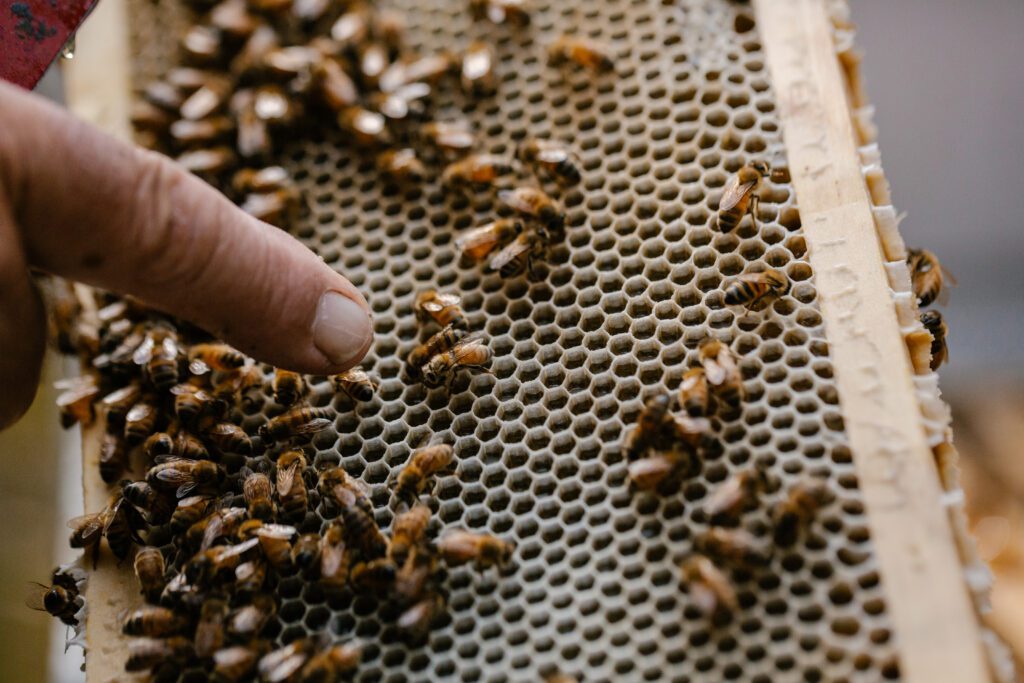
The formation of Beeswax explained
The foraging worker bee collects nectar from the flower, stores it in their abdomen and flies back to the hive where they pass it on to the “hive bees”. When combined with their saliva the hive bee uses their honey stomachs to break down the structure of the sugar content in honey before they regurgitate it into the honeycomb cells.
On the inner sides of the Honeybees abdomen, they develop 8 special wax producing glands. These glands will convert the sugar content of honey into tiny glass clear flakes of wax.
The worker will chew these flakes to help soften and when combined with pollen it will progressively get darker which gives wax a natural yellow colour.
For the bees to successfully secrete wax from their glands the temperature of the hive must be between 33°C – 36°C. If the hive gets too hot the wax foundation will weaken and possibly collapse. To maintain the temperature some of the workers will move to the outside of the hive to allow more room, airflow and ventilation inside. This process is called “Bearding” as they will form a beard like shape at the front of their hive.

Another way they regulate the temperature is for some Honeybees to collect water in their stomach and then simply spit it back out inside the hive. The airflow that moves over the water causes evaporation which acts as a cooling aid. How fascinating is that!?
Roughly one flake of wax is around 3mm x 0.1mm and is estimated that 1100 flakes are needed to make just 1 gram of wax.
The wax is used to build the honeycomb foundation which is made up of hundreds of cells. Not only do Honeybees use the cells for storing honey and pollen it is also where the Queen lays her eggs.
Worker bees build the foundation cells in a hexagon shape simply because it uses the least amount of product and holds the most amount of weight. As a hexagon will sit side by side and on top of each other with equal sides there is no wasted space.
Once the eggs hatch (day 3) they become larva and need feeding of Royal Jelly by the worker bees to grow. Around day 9 when the larva matures the workers will cap the cell with more wax. The cells will stay capped until the adult bee emerges around day 21.
Beekeepers will collect the frames from their hives (always leaving behind more than enough honey for the bees) and using the required tools or machines the process of uncapping takes place. By scraping the caps off the cells, you will end up with a pile of beeswax!
Uses for Beeswax
As beeswax never goes bad and can always be melted and reused, for centuries people have found thousands of ways to incorporate wax into every day uses.
In fact the oldest beeswax known was discovered in an old ceramic cooking vessel from Anatolia (large peninsula in Western Asia) found more than 8,000 years ago around the same time pottery was invented.
One of the oldest uses for beeswax is candle making. Pure beeswax produces negative ions when burned. Those ions help to neutralize pollutants in the air which helps eliminate dust, odours, and mould in the atmosphere, easing allergy and asthma symptoms and improving breathing for anyone nearby.
Some other common uses are:
Lip balms, furniture polishes, soap making, beard & moustache wax, lotions & moisturizers, crayons, salves, hair pomades, reusable food wraps, leather sealing, unsticking zippers, wax thread, envelope seals.
Beeswax is anti-inflammatory, antimicrobial (stops bacteria from forming), analgesic (relieves pain), you will find numerous amounts of beauty product producers also include beeswax in their formulas.

